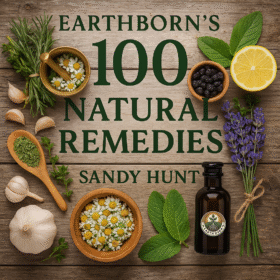
Because sore knees shouldn’t keep you out of the veggie patch.
Why gardeners care about inflammation
Pulling weeds, turning compost and lugging watering cans is rewarding—but it can leave joints cranky and muscles achy. Instead of reaching straight for the pill bottle, you can grow your own living “medicine chest” in the beds you already tend. Below are nine herbs with solid research behind them and down-to-earth tips for cultivating and using each one.
1. Turmeric – The Golden Workhorse
Why it helps: Curcumin, the bright orange pigment, tamps down the NF-κB pathway (a master switch for inflammation).
How to grow: Loves heat, dappled shade and rich, moisture-holding soil. Plant a chunk of fresh rhizome in spring once nights stay above 15 °C; dig up the whole clump after the foliage dies back next autumn.
How to use: Grate into stews, smoothies or “golden milk.” Pair with a crack of black pepper to boost absorption.
2. Ginger – Warming & Wondrous
Why it helps: Gingerol and shogaol calm cytokines like TNF-α and IL-6—think nature’s mild NSAID.
How to grow: Same conditions as turmeric; it’s perfectly happy in a 30 cm pot on a sunny patio.
How to use: Fresh slices in hot water for an instant tea, or dried powder (1–2 g/day) in capsules for steadier dosing.
3. Boswellia – The Frankincense Tree
Why it helps: Boswellic acids block 5-LOX, easing joint and gut flare-ups.
How to grow: A true arid-zone tree—excellent in a large terracotta pot with gritty, well-drained mix. Bring under cover for Cape winter rains.
How to use: Resin extracts (standardised for AKBA) are most practical: 300–500 mg twice daily.
4. Green Tea (Camellia sinensis) – Sip Your Relief
Why it helps: EGCG cools oxidative stress and dampens inflammatory signalling.
How to grow: Acid-loving evergreen shrub; best in morning sun and compost-rich, slightly acidic soil. Mulch with pine needles.
How to use: Two–three cups daily, or go matcha for a bigger catechin punch. Skip milk—it binds the goodies.
5. Rosemary – Aromatic Anti-Inflammatory
Why it helps: Rosmarinic and carnosic acids are dual COX/LOX inhibitors and brain-friendly antioxidants.
How to grow: Practically indestructible in full sun and free-draining soil; prune often to keep it bushy.
How to use: Toss generous sprigs into roast veggies or make a strong tea for a post-digging foot soak.
6. Devil’s Claw – Desert Ally
Why it helps: Harpagoside targets COX-2 and nitric-oxide pathways—great for stubborn back or knee pain.
How to grow: A true Namibian native needing deep, sandy soil and minimal water; treat like a novelty specimen.
How to use: Buy the root extract (look for 1–2% harpagoside) and follow label—usually 600 mg/day.
7. Willow Bark – Nature’s Aspirin
Why it helps: Salicin converts to salicylic acid, quieting prostaglandins and easing pain.
How to grow: White willow loves damp spots—stream edges, seasonal seeps or an oversized barrel kept moist.
How to use: Strip young bark in winter, dry and simmer 5 g in 250 mL water for 10 minutes. Not for kids with viral fevers or anyone sensitive to aspirin.
8. Holy Basil (Tulsi) – The Stress-Tamer
Why it helps: Balances cortisol spikes and reins in NF-κB, making it ideal for garden-induced (or life-induced) aches.
How to grow: Annual here—sow after last frost in rich soil, pinch flowers to keep leaves coming. The scent alone lifts spirits!
How to use: Fresh-leaf tea or 250–500 mg capsules twice daily. May nudge blood sugar down, so monitor if diabetic.
9. Rooibos – South Africa’s Own Red Gold
Why it helps: Aspalathin and nothofagin lower oxidative stress markers and soothe vascular inflammation.
How to grow: Prefers poor, sandy, slightly acidic soil and dry summers—perfect for fynbos fans. Tricky but rewarding from seed.
How to use: Steep green (unfermented) rooibos 8 minutes under a cover and enjoy 2–3 mugs a day, hot or iced.
Putting It All Together
- Kitchen first: Use culinary doses daily—think turmeric-ginger curries and rosemary-infused roast potatoes.
- Tea time ritual: Alternate green-tea, rooibos and tulsi infusions to keep things interesting.
- Supplement wisely: For stubborn joint issues, layer a standardised boswellia or devil’s-claw extract on top.
- Mind the mix: If you’re on blood thinners, diabetes meds, or have chronic conditions, chat to a qualified herbalist or pharmacist before going all-in.
Final Sprout of Wisdom
Your garden already feeds your body; with these herbs it can help heal it too. Grow them, taste them, share cuttings with neighbours, and let us know which combinations soothe your post-pruning aches the best. Happy planting—and even happier joints! 🌿


 **Meet Sprout!** Sprout is your friendly gardening companion at Earthborn, always ready with helpful advice on plant care, medicinal herbs, and natural gardening solutions. From seedling to harvest, Sprout provides expert guidance to nurture your garden and your well-being—making gardening easy, fun, and naturally rewarding.
**Meet Sprout!** Sprout is your friendly gardening companion at Earthborn, always ready with helpful advice on plant care, medicinal herbs, and natural gardening solutions. From seedling to harvest, Sprout provides expert guidance to nurture your garden and your well-being—making gardening easy, fun, and naturally rewarding.
